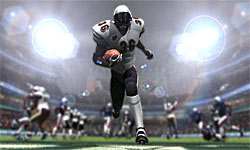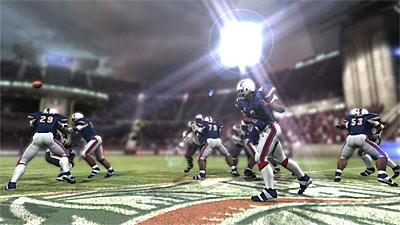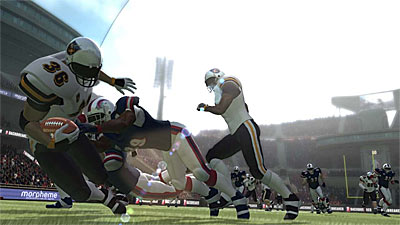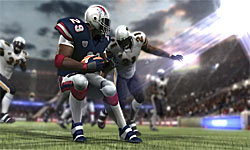Valiant Effort. Unrealized Gameplay.
It seems the only decent competitor for EA SPORTS’ Madden franchise has been their own NCAA college football franchise; ever since 2K Games bowed out, it’s been a one-horse race. That’s why when NaturalMotion and 505 Games decided to bring us a brand new, revolutionary take on the beloved sport, we got a little giddy.

You see, as much as we love EA’s sports titles, and are more or less satisfied with the amount of innovation they supply us year after year, we’d still like to see a genuine competitor arise from 2K’s ashes. After all, a little stiff competition tends to breed excellence – just look at what Konami’s PES has done for the FIFA franchise. Still, it’s always going to be an uphill battle to try and hang with Madden, let alone unseat the juggernaut. Alas, Backbreaker, in spite of all of its originality, ends up being little more than a novelty.
Unfortunately, there’s really not a whole lot here to keep savvy football gamers engaged, as the gameplay simply isn’t good. Certainly the presentation, in general, gets high marks and should be experienced by anyone that’s interested, but you can’t polish… turf. In fact, it’s the beautiful visual style that ends up killing the fun. Rather than viewing the action from the standard, withdrawn, isometric camera angle, NaturalMotion opted to bring gritty realism to the game by capturing the action from a third-person perspective. While this approach does a great job of immersing you in the play like no other, it also saps the game of its precision, eventually leading to a shallow gridiron experience.
What does Backbreaker get right? A fair amount actually. We loved that they ditched wasting money on an NFL license; leave that to EA, we’re going to buy that game anyway. Also, a lot of effort went into creating dozens of fictitious teams that are actually interesting to play due to the fact they are backed by solid iconography (such as cool logos and uniforms) as well as varied team play styles. The inclusion of “Tackle Alley,” a mini-game that pits a few defensive players against a running back in an attempt to make and break open-field tackles (depending on which side of the ball you’re playing), was a great addition as well, as it is a good bit of arcade-style fun.

They also succeeded in giving players comprehensive customization tools in order to make the game more personalized. For example, I created two teams, the Chi-town Bruise Bros. and the Midway Monsters, recreating the linebacker-friendly, running game-centric Bears teams of the 60’s and 80’s. There are also enough game modes outside of exhibition matchups, including two different league types and online play, for players to get some variation. Finally, as already mentioned, the game looks great; the physics on display are second to none, leading to bone-crunching tackles and slick grabs that never seem to repeat themselves.
All of that isn’t enough to save the game from itself, however. Disappointingly, Backbreaker gets a lot more wrong than it does right. For instance, the game is absolutely riddled with silly little issues that haven’t been present in the competition’s offering since the 90’s. Things like poor spots (forward progress is essentially non-existent), egregious, persistently uncalled offensive pass interference, missed tackles, poor time management (calling a timeout is like pulling teeth due to replay interference), and non-adaptive passing (quarterbacks seem to only be able to throw to predetermined spots) left me perplexed. The more you play, the more these little knives twist, fomenting frustration.

Even seemingly mundane aspects, such as incorporating a novice-friendly Arcade control option, which streamlines play calling, ca be horrendous. Using the Arcade controls, you’ll be at the mercy of overly-simplistic plays that are rarely appropriate for the situation at hand (forget about getting passing plays to the outside whilst approaching the end of the half or even getting a Hail Mary play until there are less than a few ticks on the clock). Likewise, even the Pro option is full of flaws. Most notably, the play selection layout is utterly inefficient and quite meager in terms of variation, and it doesn’t lend itself particularly well to multiplayer competitive play.
Additionally, playing consistent defense while fully-controlling your team is nearly impossible. Due to the game’s goofy perspective, things go best when players are on auto-pilot. Selecting a player after the huddle to defend a play more or less commits you to that player because the camera angle maximizes that player’s view and never pans out to give you a better sense of what’s going on around you. As such, you’ll be at the mercy of your AI teammates to protect you; this is especially so whilst defending against the pass. The devs tried to ameliorate this by letting you switch players on the fly. However, this causes the camera angle to shift wildly, making it very difficult to react appropriately. As such, you’re better off just letting the play run its course, which is decidedly unsatisfying.

In the beginning, I hopped online, determined to play 100% hands-on; constantly switching players to always be part of the play. This led to me getting shelled every time. After taking my lumps, I soon learned that the blitz was more or less tantamount to a win button against human opponents. As such, I decided to just let the computer take over and see if the competition could compete with the pressure. Sure enough, I sent a blitz at my opponents every down and completely turned the tables. Because passing plays take so long to develop, and QBs can’t adjust their throws sufficiently, even from blitz formations I was still picking balls off in the secondary, not to mention I completely nullified the competition’s running game.
Playing against the CPU is a bit different; spamming blitz and forgetting coverage will get you in trouble. Nevertheless, trying to take control of the individual players is asinine. You’re still better off calling for man coverage and then rushing a linebacker every play. If you do decide to sit back to dominate the passing lanes, you’ll just get hammered. Again, the perspective is so poor for playing defense effectively, you’ll never really know where the ball is going until it is too late. In the end, the game ends up playing like EA’s “Be A Pro” modes (found in several of their sports titles), where you control just one player while the game goes on around you.
Of course, controlling one player at a time doesn’t really affect gameplay on the offensive side of the ball, but offense suffers from loads of faults, too. For example, as fluid as the game evolves around you, things are surprisingly stiff whilst carrying the ball. Other than the uber-useful stiff-arm, moves such as jukes, hurdles, and spins are just as likely to take you out of bounds, back behind the line of scrimmage, or into the waiting arms of an oncoming tackler as they are to net you extra yards. Additionally, the passing mechanic is frightfully slow. In order to pass the ball, rather than hitting the receiver-appropriate face-button, you’ll have to hold down the focus button and use the analog stick to lob or gun the ball in. While focused, you can’t scramble or even make minor adjustments in the pocket. This leaves you wide-open to sacks.
Not only are the throwing mechanics pointlessly tethered to the analog stick, so too are the receiver routes. While in focus mode, you’ll tap to the left or right in order to run through your receivers. This sounds simple enough, but it inevitably means you’ll mistakenly pass to the wrong receiver. In fact, pretty much every offensive series I ended up passing to a covered receiver because the game interpreted my stick inputs differently than what I had intended. This is a serious control flaw that plagues the passing game. This game screams for the standard face-button control scheme, but it shuns it for no other reason than to be original.
So it is with practically every other aspect of Backbreaker; it seems like the devs did things differently for the sake of being unique. Unfortunately, more often than not, this leads to unsound gameplay mechanics. I could go on and on dissecting the game, pointing out its myriad flaws, but there simply isn’t enough space afforded to me to do so. Besides, such tirades are boring to read. Just know that this game is full of missteps. That doesn’t mean it is completely unrewarding, it just can’t hang with the competition. In the end, this is a distinct take on football that is worth playing as a rental, but even at its discounted retail price isn’t worth the price of admission.
RATING OUT OF 5 RATING DESCRIPTION 3.5 Graphics
The physics are great and the action is captured in a very visceral way. Unfortunately, the perspective and constantly-changing camera angles just aren’t conducive to precision gameplay. 2.5 Control
Controls are barely good enough. Passing, especially, is ludicrously implemented. Defensively, your best served just calling a money play and letting the friendly AI takeover. 2.5 Music / Sound FX / Voice Acting
The sound effects are fine, but hits sound like the popping of weak firecrackers. The lack of commentary is both a blessing and a blight. 3.0 Play Value
There is some fun to be found here, but the novelty wears off too quickly. 2.8 Overall Rating – Average
Not an average. See Rating legend above for a final score breakdown.
Game Features:
